The long and short scales are two of several naming systems for integer powers of ten which use some of the same terms for different magnitudes. For whole numbers smaller than 1,000,000,000 (109), such as one thousand or one million, the two scales are identical. For larger numbers, starting with 109, the two systems differ. For identical names, the long scale proceeds by powers of one million, whereas the short scale proceeds by powers of one thousand. For example, "one billion" means one thousand millions in the short scale, while it means one million millions in the long scale. The long scale system uses additional terms for the intervening values, typically replacing the word ending -ion with -iard.
- integer powers
- naming
- iard
1. Scales
In both short and long scale naming, names are given each multiplication step for increments of the base-10 exponent of three, i.e. for each integer n in the sequence of multipliers 103n. For certain multipliers, including those for all numbers smaller than 109, both systems use the same names. The differences arise from the assignment of identical names to specific values of n, for numbers starting with 109, for which n=3. In the short scale system, the identical names are for n=3, 4, 5, ..., while the long scale places them at n=4, 6, 8, etc.
1.1. Short Scale
In the short scale, billion means a thousand millions (1,000,000,000 which is 109), trillion means one thousand billions (1012), and so on. Thus, an n-illion equals 103n+3.[1]
1.2. Long Scale
In the long scale, billion means one million millions (1012) and trillion means one million billions (1018), and so on. Therefore, an n-illion equals 106n.[2][3] In some languages, the long scale uses additional names for the interleaving multipliers, replacing the ending -ion with -iard; for example, the next multiplier after million is milliard, after billion it is billiard. Hence, an n-iard equals 106n+3.
2. Use
Countries with usage of the long scale include most countries in continental Europe and most that are French-speaking, German-speaking, Spanish-speaking[4] and Portuguese-speaking countries (except Brazil ).
The short scale was never widespread before its universal adoption in the United States. It has been taught in school since the early 1800s. It has since become common in other English-speaking nations and several other countries.
Number names are rendered in the language of the country, but are similar due to shared etymology. Some languages, particularly in East Asia and South Asia, have large number naming systems that are different from both the long and short scales, for example the Indian numbering system.[2][3]
For most of the 19th and 20th centuries, the United Kingdom largely used the long scale,[1][5] whereas the United States used the short scale,[5] so that the two systems were often referred to as British and American in the English language. After several decades of increasing informal British usage of the short scale, in 1974 the government of the UK adopted it,[6] and it is used for all official purposes.[7][8][9][10][11] With very few exceptions,[12] the British usage and American usage are now identical.
The first recorded use of the terms short scale (French: échelle courte) and long scale (French: échelle longue) was by the French mathematician Geneviève Guitel in 1975.[2][3]
To avoid confusion resulting from the coexistence of short and long term in any language, the International System of Units (SI) recommends using the metric prefix to indicate orders of magnitude, but it is only relevant to scientific applications, and not (for example) to finance. Unlike words like billion and trillion, metric prefixes keep the same meaning regardless of the country and the language.
3. Comparison
The relationship between the numeric values and the corresponding names in the two scales can be described as:
| Value in scientific notation |
Metric prefix | Value in positional notation | Short scale | Long scale | ||||
|---|---|---|---|---|---|---|---|---|
| Prefix | Symbol | Name | Logic | Name | Alternative name | Logic | ||
| 100 | 1 | one | one | |||||
| 101 | deca | da | 10 | ten | ten | |||
| 102 | hecto | h | 100 | hundred | hundred | |||
| 103 | kilo | k | 1,000 | thousand | thousand | |||
| 106 | mega | M | 1,000,000 | million | 1,000 × 1,0001 | million | 1,000,0001 | |
| 109 | giga | G | 1,000,000,000 | billion | 1,000 × 1,0002 | milliard | thousand million | 1,000 × 1,000,0001 |
| 1012 | tera | T | 1,000,000,000,000 | trillion | 1,000 × 1,0003 | billion | 1,000,0002 | |
| 1015 | peta | P | 1,000,000,000,000,000 | quadrillion | 1,000 × 1,0004 | billiard | thousand billion | 1,000 × 1,000,0002 |
| 1018 | exa | E | 1,000,000,000,000,000,000 | quintillion | 1,000 × 1,0005 | trillion | 1,000,0003 | |
| 1021 | zetta | Z | 1,000,000,000,000,000,000,000 | sextillion | 1,000 × 1,0006 | trilliard | thousand trillion | 1,000 × 1,000,0003 |
| 1024 | yotta | Y | 1,000,000,000,000,000,000,000,000 | septillion | 1,000 × 1,0007 | quadrillion | 1,000,0004 | |
The relationship between the names and the corresponding numeric values in the two scales can be described as:
| Name | Short scale | Long scale | ||||||
|---|---|---|---|---|---|---|---|---|
| Value in scientific notation |
Metric prefix | Logic | Value in scientific notation |
Metric prefix | Logic | |||
| Prefix | Symbol | Prefix | Symbol | |||||
| million | 106 | mega | M | 1,000 × 1,0001 | 106 | mega | M | 1,000,0001 |
| billion | 109 | giga | G | 1,000 × 1,0002 | 1012 | tera | T | 1,000,0002 |
| trillion | 1012 | tera | T | 1,000 × 1,0003 | 1018 | exa | E | 1,000,0003 |
| quadrillion | 1015 | peta | P | 1,000 × 1,0004 | 1024 | yotta | Y | 1,000,0004 |
| etc. | To next named order of magnitude: multiply by 1,000 |
To next named order of magnitude: multiply by 1,000,000 |
||||||
The root mil in million does not refer to the numeral, 1. The word, million, derives from the Old French, milion, from the earlier Old Italian, milione, an intensification of the Latin word, mille, a thousand. That is, a million is a big thousand, much as a great gross is a dozen gross or 12 × 144 = 1728.[13]
The word milliard, or its translation, is found in many European languages and is used in those languages for 109. However, it is not found in American English, which uses billion, and not used in British English, which preferred to use thousand million before the current usage of billion. The financial term yard, which derives from milliard, is used on financial markets, as, unlike the term billion, it is internationally unambiguous and phonetically distinct from million. Likewise, many long scale countries use the word billiard (or similar) for one thousand long scale billions (i.e., 1015), and the word trilliard (or similar) for one thousand long scale trillions (i.e., 1021), etc.[14][15][16][17][18]
4. History
The existence of the different scales means that care must be taken when comparing large numbers between languages or countries, or when interpreting old documents in countries where the dominant scale has changed over time. For example, British English, French, and Italian historical documents can refer to either the short or long scale, depending on the date of the document, since each of the three countries has used both systems at various times in its history. Today, the United Kingdom officially uses the short scale, but France and Italy use the long scale.
The pre-1974 former British English word billion, post-1961 current French word billion, post-1994 current Italian word bilione, Spanish billón, German Billion, Dutch biljoen, Danish billion, Swedish biljon, Finnish biljoona, Slovenian bilijon, Polish bilion, and European Portuguese word bilião (with a different spelling to the Brazilian Portuguese variant, but in Brazil referring to short scale) all refer to 1012, being long-scale terms. Therefore, each of these words translates to the American English or post-1974 British English word: trillion (1012 in the short scale), and not billion (109 in the short scale).
On the other hand, the pre-1961 former French word billion, pre-1994 former Italian word bilione, Brazilian Portuguese word bilhão, and Welsh word biliwn all refer to 109, being short scale terms. Each of these words translates to the American English or post-1974 British English word billion (109 in the short scale).
The term billion originally meant 1012 when introduced.[13]
- In long scale countries, milliard was defined to its current value of 109, leaving billion at its original 1012 value and so on for the larger numbers.[13] Some of these countries, but not all, introduced new words billiard, trilliard, etc. as intermediate terms.[14][15][16][17][18]
- In some short scale countries, milliard was defined to 109 and billion dropped altogether, with trillion redefined down to 1012 and so on for the larger numbers.[13]
- In many short scale countries, milliard was dropped altogether and billion was redefined down to 109, adjusting downwards the value of trillion and all the larger numbers.
Timeline
| Date | Event |
|---|---|
| 13th century | The word million was not used in any language before the 13th century. Maximus Planudes (c. 1260–1305) was among the first recorded users.[13] |
| Late 14th century |
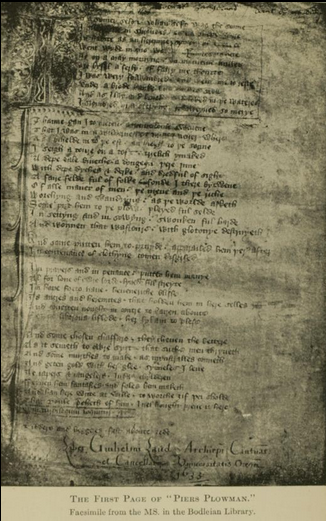 Piers Plowman, a 17th-century copy of the original 14th-century allegorical narrative poem by William Langland. https://handwiki.org/wiki/index.php?curid=1942944
Translation:
|
| 1475 | French mathematician Jehan Adam, writing in Middle French, recorded the words bymillion and trimillion as meaning 1012 and 1018 respectively in a manuscript Traicté en arismetique pour la practique par gectouers, now held in the Bibliothèque Sainte-Geneviève in Paris.[19][20][21]
Translation:
|
| 1484 |
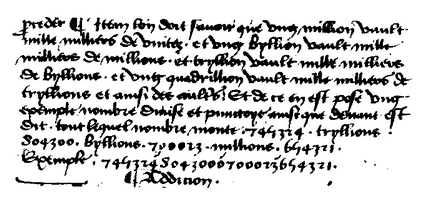 Le Triparty en la Science des Nombres par Maistre Nicolas Chuquet Parisien
an extract from Chuquet's original 1484 manuscript. https://handwiki.org/wiki/index.php?curid=1521584
Translation:
The extract from Chuquet's manuscript, the transcription and translation provided here all contain an original mistake: one too many zeros in the 804300 portion of the fully written out example: 745324'8043000 '700023'654321 ... |
| 1516 |
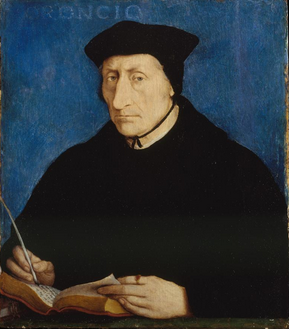
Guilielmus Budaeus or Guillaume Budé (1467–1540). https://handwiki.org/wiki/index.php?curid=1575453
Translation:
|
| 1549 | The influential French mathematician Jacques Pelletier du Mans used the name milliard (or milliart) to mean 1012, attributing the term to the earlier usage by Guillaume Budé[25] |
| 17th century | With the increased usage of large numbers, the traditional punctuation of large numbers into six-digit groups evolved into three-digit group punctuation. In some places, the large number names were then applied to the smaller numbers, following the new punctuation scheme. Thus, in France and Italy, some scientists then began using billion to mean 109, trillion to mean 1012, etc.[26] This usage formed the origins of the later short scale. The majority of scientists either continued to say thousand million or changed the meaning of the Pelletier term, milliard, from "million of millions" down to "thousand million".[13] This meaning of milliard has been occasionally used in England,[5] but was widely adopted in France, Germany, Italy and the rest of Europe, for those keeping the original long scale billion from Adam, Chuquet and Pelletier. |
| 1676 | The first published use of milliard as 109 occurred in the Netherlands.[13][27]
Translation:
|
| 18th century | The short-scale meaning of the term billion was brought to the British American colonies. As early as 1762 (and through at least the early 20th century), the dictionary of the Académie française defined billion as a term of arithmetic meaning a thousand millions.[28][29][30][31] |
| 1729 | The first American appearance of the short scale value of billion as 109 was published in the Greenwood Book of 1729, written anonymously by Prof. Isaac Greenwood of Harvard College[13] |
| Early 19th century | France widely converted to the short scale, and was followed by the U.S., which began teaching it in schools. Many French encyclopedias of the 19th century either omitted the long scale system or called it "désormais obsolète", a now obsolete system. Nevertheless, by the mid 20th century France would officially convert back to the long scale. |
| 1926 |
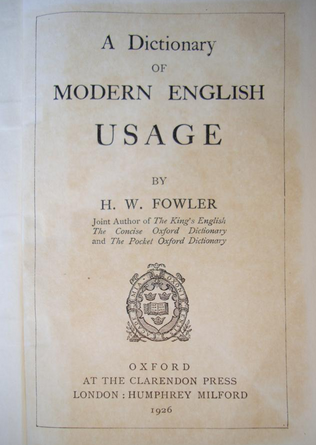 A Dictionary of Modern English Usage
by H. W. Fowler. https://handwiki.org/wiki/index.php?curid=1158087
Although American English usage did not change, within the next 50 years French usage changed from short scale to long and British English usage changed from long scale to short. |
| 1948 | The 9th General Conference on Weights and Measures received requests to establish an International System of Units. One such request was accompanied by a draft French Government discussion paper, which included a suggestion of universal use of the long scale, inviting the short-scale countries to return or convert.[32] This paper was widely distributed as the basis for further discussion. The matter of the International System of Units was eventually resolved at the 11th General Conference in 1960. The question of long scale versus short scale was not resolved and does not appear in the list of any conference resolutions.[32][33] |
| 1960 | The 11th General Conference on Weights and Measures adopted the International System of Units (SI), with its own set of numeric prefixes.[34] SI is therefore independent of the number scale being used. SI also notes the language-dependence of some larger-number names and advises against using ambiguous terms such as billion, trillion, etc.[35] The National Institute of Standards and Technology within the US also considers that it is best that they be avoided entirely.[36] |
| 1961 | The French Government confirmed their official usage of the long scale in the Journal officiel (the official French Government gazette).[37] |
| 1974 |
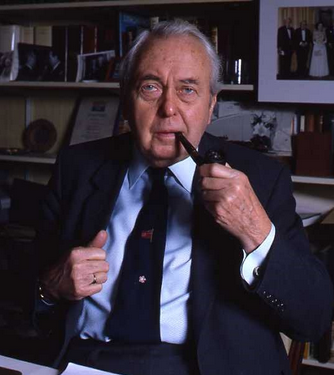 British prime minister Harold Wilson
(1916–1995). https://handwiki.org/wiki/index.php?curid=1792807
The BBC and other UK mass media quickly followed the government's lead within the UK. During the last quarter of the 20th century, most other English-speaking countries (Ireland, Australia, New Zealand, South Africa, Zimbabwe, etc.) either also followed this lead or independently switched to the short scale use. However, in most of these countries, some limited long scale use persists and the official status of the short scale use is not clear. |
| 1975 | French mathematician Geneviève Guitel introduced the terms long scale (French: échelle longue) and short scale (French: échelle courte) to refer to the two numbering systems.[2][3] |
| 1994 | The Italian Government confirmed their official usage of the long scale.[18] |
As large numbers in natural sciences are usually represented by metric prefixes, scientific notation or otherwise, the most commonplace occurrence of large numbers represented by long or short scale terms is in finance. The following table includes some historic examples related to hyper-inflation and other financial incidents.
- Timeline
| Date | Event |
|---|---|
| 1923 |
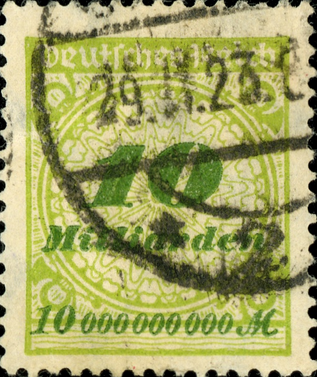 10 Milliarden Mark (1010 mark) stamp. https://handwiki.org/wiki/index.php?curid=1594258
 1000 Mark German banknote, over-stamped in red with "Eine Milliarde Mark" (109 mark). https://handwiki.org/wiki/index.php?curid=1416395
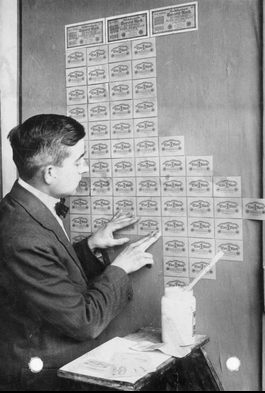 Using German banknotes as wallpaper following the 1923 hyperinflation. https://handwiki.org/wiki/index.php?curid=1610046
German hyperinflation in the 1920s Weimar Republic caused 'Eintausend Mark' (1000 Mark = 103 Mark) German banknotes to be over-stamped as 'Eine Milliarde Mark' (109 Mark). This introduced large-number names to the German populace. The Mark or Papiermark was replaced at the end of 1923 by the Rentenmark at an exchange rate of 1 Rentenmark = 1 billion (long scale) Papiermark = 1012 Papiermark = 1 trillion (short scale) Papiermark |
| 1946 |
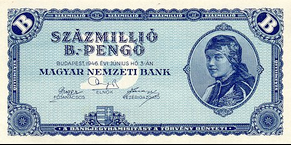 1020 Hungarian pengő banknote issued in 1946. https://handwiki.org/wiki/index.php?curid=1689441
Hyperinflation in Hungary in 1946 led to the introduction of the 1020 pengő banknote. 100 million b-pengő (long scale) = 100 trillion (long scale) pengő = 1020 pengő = 100 quintillion (short scale) pengő. On 1 August 1946, the forint was introduced at a rate of 1 forint = 400 quadrilliard (long scale) pengő = 4 × 1029 pengő = 400 octillion (short scale) pengő. |
| 1993 |
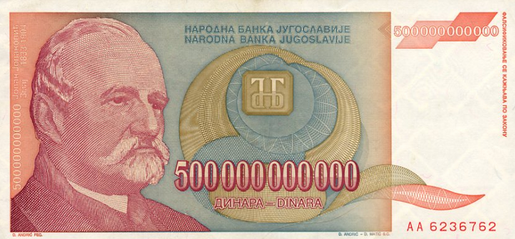 5 × 1011 Yugoslav dinar banknotes from 1993. https://handwiki.org/wiki/index.php?curid=1778851
Hyperinflation in Yugoslavia led to the introduction of 5 × 1011 dinar banknotes. 500 thousand million (long scale) dinars = 5 × 1011 dinar banknotes = 500 billion (short scale) dinars. The later introduction of the new dinar came at an exchange rate of 1 new dinar = 1 × 1027 dinars = ~1.3 × 1027 pre 1990 dinars. |
| 2009 |
 1014 Zimbabwean dollars banknote from 2009. https://handwiki.org/wiki/index.php?curid=1653469
Hyperinflation in Zimbabwe led to banknotes of 1014 Zimbabwean dollars, marked "One Hundred Trillion Dollars" (short scale), being issued in 2009, shortly ahead of the currency being abandoned[38][39][40] after a final redenomination to the 'fourth dollar'. From 2013 to 2019 when the RTGS Dollar entered use, no new currency was announced, and so foreign currencies were used instead. 100 trillion (short scale) Zimbabwean dollars = 1014 Zimbabwean dollars = 100 billion (long scale) Zimbabwean dollars = 1027 pre-2006 Zimbabwean dollars = 1 quadrilliard (long scale) pre-2006 Zimbabwean dollars. |
| 2013 | (As of October 2013), the combined total public debt of the United States stood at United States dollar 17.078 trillion.[41][42]
17 trillion (short scale) US Dollars = 1.7 × 1013 US Dollars = 17 billion (long scale) US Dollars |
5. Current Usage

Short scale users
English-speaking
Most English-language countries and regions use the short scale with 109 being billion. For example:[43]
- American Samoa
- Anguilla
- Antigua and Barbuda
- Australia [44][45]
- Bahamas
- Barbados
- Belize (English-speaking)
- Bermuda
- Botswana (English-speaking)
- British Virgin Islands
- Cameroon (English-speaking)
- Canada (English-speaking) see Using both below
- Cayman Islands
- Cook Islands
- Dominica
- Eritrea
- Eswatini (formerly Swaziland)
- Ethiopia
- Falkland Islands
- Fiji
- Gambia
- Ghana (English-speaking)
- Gibraltar
- Grenada
- Guam
- Guyana (English-speaking)
- Hong Kong (English-speaking)
- Ireland (English-speaking, Irish: billiún, trilliún)
- Isle of Man
- Jamaica
- Jersey
- Kenya (English-speaking)
- Kiribati
- Lesotho
- Liberia
- Malawi (English-speaking)
- Malaysia (English-speaking; Malay: bilion billion, trilion trillion)
- Malta (English-speaking; Maltese: biljun, triljun
- Marshall Islands
- Mauritius (English speaking) see Using both below
- Federated States of Micronesia
- Montserrat
- Nauru
- New Zealand
- Nigeria (English-speaking)
- Niue
- Norfolk Island
- Northern Mariana Islands
- Palau
- Papua New Guinea (English-speaking)
- Philippines (English-speaking) [46]
- Pitcairn Islands
- Rwanda
- Saint Helena, Ascension and Tristan da Cunha
- Saint Kitts and Nevis
- Saint Lucia
- Saint Vincent and the Grenadines
- Samoa
- Seychelles (English speaking) see Using both below
- Sierra Leone
- Singapore (English-speaking)
- Solomon Islands
- South Georgia and the South Sandwich Islands
- South Sudan (English-speaking)
- Tanzania (English-speaking)
- Tokelau
- Tonga
- Trinidad and Tobago
- Turks and Caicos Islands
- Tuvalu
- Uganda (English-speaking)
- United Kingdom (see also Wales below) [6][7][9][10][47][48]
- United States[49][50][51]
- Vanuatu (English speaking) see Using both below
- Zambia (English-speaking)
- Zimbabwe (English-speaking)[38][39][40]
Arabic-speaking
Most Arabic-language countries and regions use the short scale with 109 being مليار milyar, except for a few countries like Saudi Arabia and the UAE which use the word بليون billion for 109. For example:[52][53][54]
- Algeria
- Bahrain
- Chad
- Comoros
- Djibouti
- Egypt
- Eritrea
- Iraq
- Jordan
- Kuwait
- Lebanon
- Libya
- Mauritania
- Morocco
- Oman
- Palestine
- Qatar
- Saudi Arabia
- Somalia
- Sudan
- Syria
- Tunisia
- United Arab Emirates
- Yemen
Other short scale
Other countries also use a word similar to trillion to mean 1012, etc. Whilst a few of these countries like English use a word similar to billion to mean 109, most like Arabic have kept a traditional long scale word similar to milliard for 109. Some examples of short scale use, and the words used for 109 and 1012, are
- Afghanistan (Dari: میلیارد milyard or بیلیون billion, تریلیون trillion, Pashto: میلیارد milyard, بیلیون billion, تریلیون trillion)
- Albania (miliard, trilion)[55]
- Armenia ( միլիարդ miliard, տրիլիոն trilion)
- Azerbaijan (milyard, (trilyon)
- Belarus (мільярд milyard, трыльён trilyon)
- Brazil (Brazilian Portuguese: bilhão, trilhão)
- Brunei (Malay: bilion, trilion)
- Bulgaria (милиард miliard, трилион trilion)
- Cyprus (Greek: δισεκατομμύριο disekatommyrio, τρισεκατομμύριο trisekatommyrio, Turkish: milyar, trilyon)
- Estonia (miljard or biljon[56], triljon)[57][58][59]
- Georgia (მილიარდი miliardi, ტრილიონი trilioni)
- Indonesia (miliar, triliun)[60][61]
- Israel (Hebrew: מיליארד milyard, טריליון trilyon)
- Kazakhstan (Kazakh: миллиард milliard, триллион trillion)
- Kyrgyzstan (Kyrgyz: миллиард milliard, триллион trillion)
- Latvia (miljards, triljons)
- Lithuania (milijardas, trilijonas)
- Moldova (Romanian:[62] miliard, trilion)
- Myanmar (formerly Burma) (Burmese: ဘီလျံ, IPA: [bìljàɰ̃]; ထရီလျံ, [tʰəɹìljàɰ̃])[63]
- Namibia (Afrikaans speaking) see Using both below
- Puerto Rico (Spanish speaking) see Using both below
- Russia (миллиард milliard, триллион trillion)
- South Africa (Afrikaans speaking) see Using both below
- Tajikistan (Tajik: миллиард milliard, триллион trillion)
- Turkey (milyar, trilyon)
- Ukraine (мільярд mil'yard, трильйон tryl'yon)
- Uzbekistan (Uzbek: milliard, trillion; Russian: миллиард milliard, триллион trillion)
- Template:WAL (biliwn, triliwn) (In some contexts a paraphrase is needed to resolve ambiguity, as the lenitive of both miliwn and biliwn is the same: filiwn.)
Long scale users
The traditional long scale is used by most Continental European countries and by most other countries whose languages derive from Continental Europe (with the notable exceptions of Albania, Greece, Romania,[62] and Brazil). These countries use a word similar to billion to mean 1012. Some use a word similar to milliard to mean 109, while others use a word or phrase equivalent to thousand millions.
Dutch-speaking
Most Dutch-language countries and regions use the long scale with 109 = miljard, for example:[64][65]
- Aruba
- Belgium
- Netherlands
- Suriname
French-speaking
Most French-language countries and regions use the long scale with 109 = milliard, for example:[66][67][68]
- Belgium
- Benin
- Burkina Faso
- Canada (Canadian French) see Using both below
- Central African Republic
- Democratic Republic of the Congo
- Republic of the Congo
- France
- French Polynesia
- Gabon
- Guinea
- Haiti
- Ivory Coast (Côte d'Ivoire)
- Mali
- Monaco
- New Caledonia
- Niger
- Template:QC (province of Canada, Canadian French) see Using both below
- Template:MAF (French portion of St. Martin Island)
- Senegal
- Togo
German-speaking
German-language countries and regions use the long scale with 109 = Milliarde, for example:
Portuguese-speaking
With the notable exception of Brazil, a short scale country, most Portuguese-language countries and regions use the long scale with 109 = mil milhões or milhar de milhões, for example:
- Angola
- Cape Verde
- Guinea-Bissau
- Macau
- Mozambique
- Portugal
- São Tomé and Príncipe
Spanish-speaking
Most Spanish-language countries and regions use the long scale, for example:[69][70][71]
- Argentina
- Bolivia
- Chile
- Colombia
- Costa Rica
- Cuba
- Dominican Republic
- Ecuador
- El Salvador
- Equatorial Guinea
- Guatemala (millardo)
- Honduras (millardo)
- Mexico (mil millones or millardo)
- Nicaragua (mil millones or millardo)
- Panama (mil millones or millardo)
- Paraguay
- Peru (mil millones)
- Puerto Rico see Using both below
- Spain (millardo or typ. mil millones)
- Uruguay
- Venezuela
Other long scale
Some examples of long scale use, and the words used for 109 and 1012, are
- Andorra (Catalan: miliard or typ. mil milions, bilió)
- Bosnia and Herzegovina (Bosnian: milijarda, bilion; Croatian: milijarda, bilijun, Serbian: милијарда milijarda, билион bilion)
- Croatia (milijarda, bilijun)
- Czech Republic (miliarda, bilion)
- Denmark (milliard, billion)
- Esperanto (miliardo, duiliono) [72][73]
- Finland (Finnish: miljardi, biljoona; Swedish: miljard, biljon)
- Greenland (milliardi, billioni)
- Hungary (milliárd, billió or ezermilliárd)
- Iceland (milljarður, billjón)
- Italy (miliardo, bilione) [18][74][75]
- Luxembourg (French: milliard, billion; German: Milliarde, Billion; Luxembourgish: milliard, billioun)
- Madagascar (French: milliard, billion; Template:Lang-mg, arivo miliara)
- Mauritius (English speaking) see Using both below
- Montenegro (Montenegrin: milijarda, bilion)
- Namibia (Afrikaans speaking) see Using both below
- Template:NMK (милијарда milijarda, билион bilion)
- Norway (Bokmål: milliard, billion; Nynorsk: milliard, billion)
- Poland (miliard, bilion)
- Romania[76] (miliard, bilion). There are ambiguities for numbers above 1012.[77]
- San Marino (Italian: miliardo, bilione)
- Serbia (милијарда milijarda, билион bilion)
- Seychelles (English speaking) see Using both below
- Slovakia (miliarda, bilión)
- Slovenia (milijarda, bilijon)
- South Africa (Afrikaans speaking) see Using both below
- Sweden (miljard, biljon)
- Switzerland (French: milliard, billion; German: Milliarde, Billion; Italian: miliardo, bilione; Romansh: milliarda, billiun[78])
- Vanuatu (English speaking) see Using both below
Using both
Some countries use either the short or long scales, depending on the internal language being used or the context.
| Country or territory | Short scale usage | Long scale usage |
|---|---|---|
| Canada[79] | Canadian English (109 = billion, 1012 = trillion) | Canadian French (109 = milliard, 1012 = billion[80] or mille milliards). |
| Mauritius; Seychelles; Vanuatu | English (109 = billion, 1012 = trillion) | French (109 = milliard, 1012 = billion) |
|
Namibia South Africa[81] |
South African English (109 = billion, 1012 = trillion) | Afrikaans (109 = miljard, 1012 = biljoen) |
| Puerto Rico | Economic and technical (109 = billón, 1012 = trillón) | Latin American export publications (109 = millardo or mil millones, 1012 = billón) |
Using neither
The following countries use naming systems for large numbers that are not etymologically related to the short and long scales:
| Country | Number system | Naming of large numbers |
|---|---|---|
| Bangladesh,India,Maldives, Nepal, Pakistan | Indian numbering system | For everyday use, but short or long scale may also be in use [82] |
| Bhutan | Dzongkha numerals | Traditional system |
| Cambodia | Khmer numerals | Traditional system |
|
People's Republic of China Republic of China South Korea North Korea Japan |
East Asian numbering system:
|
Traditional myriad system for the larger numbers; special words and symbols up to 1068 |
| Greece | Calque of the short scale | Names of the short scale have not been loaned but calqued into Greek, based on the native Greek word for million, εκατομμύριο ekatommyrio ("hundred-myriad", i.e. 100×10000):
|
| Laos | Lao numerals | Traditional system |
| Mongolia | Mongolian numerals | Traditional myriad system for the larger numbers; special words up to 1067 |
| Sri Lanka |
|
Traditional systems |
| Thailand | Thai numerals | Traditional system based on millions |
| Vietnam | Vietnamese numerals | Traditional system(s) based on thousands |
By continent
The long and short scales are both present on most continents, with usage dependent on the language used. Examples include:
| Continent | Short scale usage | Long scale usage |
|---|---|---|
| Africa | Arabic (Egypt, Libya, Tunisia), English (South Sudan), South African English | Afrikaans, French (Benin, Central African Republic, Gabon, Guinea), Portuguese (Angola, Mozambique) |
| North America | American English, Canadian English | U.S. Spanish, Canadian French, Mexican Spanish |
| South America | Brazilian Portuguese, English (Guyana) | American Spanish, Dutch (Suriname), French (French Guiana) |
| Antarctica | Australian English, British English, New Zealand English, Russian | American Spanish (Argentina, Chile), French (France), Norwegian (Norway) |
| Asia | Burmese (Myanmar), Hebrew (Israel), Indonesian, Malaysian English, Philippine English, Kazakh, Uzbek, Kyrgyz | Portuguese (East Timor, Macau), Persian (Iran) |
| Europe | British English, Welsh, Estonian, Greek, Latvian, Lithuanian, Russian, Turkish, Ukrainian | Danish, Dutch, Finnish, French, German, Icelandic, Italian, Norwegian, Polish, Portuguese, Romanian, Spanish, Swedish and most other languages of continental Europe |
| Oceania | Australian English, New Zealand English | French (French Polynesia, New Caledonia) |
Notes on current usage
Short scale
- ↑ English language countries: Apart from the United States, the long scale was used for centuries in many English language countries before being superseded in recent times by short scale usage. Because of this history, some long scale use persists[12] and the official status of the short scale in anglophone countries other than the UK and US is sometimes obscure.
- ↑ Australian usage: In Australia, education, media outlets, and literature all use the short scale in line with other English-speaking countries. The current recommendation by the Australian Government Department of Finance and Deregulation (formerly known as AusInfo), and the legal definition, is the short scale.[45] As recently as 1999, the same department did not consider short scale to be standard, but only used it occasionally. Some documents use the term thousand million for 109 in cases where two amounts are being compared using a common unit of one 'million'.
- ↑ Filipino usage: Some short-scale words have been adopted into Filipino.
- ↑ British usage: Billion has meant 109 in most sectors of official published writing for many years now. The UK government, the BBC, and most other broadcast or published mass media, have used the short scale in all contexts since the mid-1970s.[6][7][9][48]
Before the widespread use of billion for 109, UK usage generally referred to thousand million rather than milliard.[10] The long scale term milliard, for 109, is obsolete in British English, though its derivative, yard, is still used as slang in the London money, foreign exchange, and bond markets.
- ↑ American usage: In the United States, the short scale has been taught in school since the early 19th century. It is therefore used exclusively.[50][51]
- ↑ Arabic language countries: Most Arabic-language countries use: 106, مليون million; 109, مليار milyar; 1012, ترليون trilyon; etc.[53][54]
- ↑ Estonian usage: Biljon is used due to English influences and is less common than miljard.
- ↑ Indonesian usage: Large numbers are common in Indonesia, in part because its currency (rupiah) is generally expressed in large numbers (the lowest common circulating denomination is Rp100 with Rp1000 is considered as base unit). The term juta, equivalent to million (106), is generally common in daily life. Indonesia officially employs the term miliar (derived from the long scale Dutch word miljard) for the number 109, with no exception. For 1012 and greater, Indonesia follows the short scale, thus 1012 is named triliun. The term seribu miliar (a thousand milliards) or more rarely sejuta juta (a million millions) or sejuta berkali-kali (a millions after a million or a millions over a million) are also used for 1012 less often. Terms greater than triliun are not very familiar to Indonesians.[61]
Long scale
- ↑ French usage: France, with Italy, was one of two European countries which converted from the long scale to the short scale during the 19th century, but returned to the original long scale during the 20th century. In 1961, the French Government confirmed their long scale status.[37][67][68] However the 9th edition of the dictionary of the Académie française describes billion as an outdated synonym of milliard, and says that the new meaning of 1012 was decreed in 1961, but never caught on.[84]
- ↑ Spanish language countries: Spanish-speaking countries sometimes use millardo (milliard)[70] for 109, but mil millones (thousand millions) is used more frequently. The word billón is sometimes used in the short scale sense in those countries more influenced by the United States, where "billion" means "one thousand millions". The usage of billón to mean "one thousand millions", controversial from the start, was denounced by the Royal Spanish Academy as recently as 2010,[71] but was finally accepted in a later version of the official dictionary as standard usage among educated Spanish speakers in the United States (including Puerto Rico).[85]
- ↑ Esperanto language usage: The Esperanto language words biliono, triliono etc. used to be ambiguous, and both long and short scale were used and presented in dictionaries. The current edition of the main Esperanto dictionary PIV however recommends the long scale meanings, as does the grammar PMEG.[73] Ambiguity may be avoided by the use of the unofficial but generally recognised suffix -iliono, whose function is analogous to the long scale, i.e. it is appended to a (single) numeral indicating the power of a million, e.g. duiliono (from du meaning "two") = biliono = 1012, triiliono = triliono = 1018, etc. following the 1×106X long scale convention. Miliardo is an unambiguous term for 109, and generally the suffix -iliardo, for values 1×106X+3, for example triliardo = 1021 and so forth.
- ↑ Italian usage: Italy, with France, was one of the two European countries which partially converted from the long scale to the short scale during the 19th century, but returned to the original long scale in the 20th century. In 1994, the Italian Government confirmed its long scale status.[18] In Italian, the word bilione officially means 1012, trilione means 1018, etc.. Colloquially, bilione[75] can mean both 109 and 1012; trilione can mean both 1012 and (rarer) 1018 and so on. Therefore, in order to avoid ambiguity, they are seldom used. Forms such as miliardo (milliard) for 109, mille miliardi (a thousand milliards) for 1012, un milione di miliardi (a million milliards) for 1015, un miliardo di miliardi (a milliard of milliards) for 1018, mille miliardi di miliardi (a thousand milliard of milliards) for 1021 are more common.[18]
Both long and short scale
- ↑ Canadian usage: Both scales are in use currently in Canada. English-speaking regions use the short scale exclusively, while French-speaking regions use the long scale, though the Canadian government standards website recommends that in French billion and trillion be avoided, recommending milliard for 109, and mille milliards (a thousand milliards) for 1012.[86]
- ↑ South African usage: South Africa uses both the long scale (in Afrikaans and sometimes English) and the short scale (in English). Unlike the 1974 UK switch, the switch from long scale to short scale took time. (As of 2011) most English language publications use the short scale. Some Afrikaans publications briefly attempted usage of the "American System" but that has led to comment in the papers[87] and has been disparaged by the "Taalkommissie" (The Afrikaans Language Commission of the South African Academy of Science and Art)[88] and has thus, to most appearances, been abandoned.
Neither long nor short scale
- ↑ Indian, Pakistani and Bangladeshi usage: Outside of financial media, the use of billion by Bangladeshi, Indian and Pakistani English speakers highly depends on their educational background. Some may continue to use the traditional British long scale. In everyday life, Bangladeshis, Indians and Pakistanis largely use their own common number system, commonly referred to as the Indian numbering system – for instance, Bangladeshi, Pakistani, and Indian English commonly use the words lakh to denote 100 thousand, crore to denote ten million (i.e. 100 lakhs) and arab to denote thousand million.[89]
6. Alternative Approaches
- In written communications, the simplest solution for moderately large numbers is to write the full amount, for example 1,000,000,000,000 rather than 1 trillion (short scale) or 1 billion (long scale).
- Combinations of the unambiguous word million, for example: 109 = "one thousand million"; 1012 = "one million million".[90]
- Scientific notation (also known as standard form or exponential notation, for example 1×109, 1×1010, 1×1011, 1×1012, etc.), or its engineering notation variant (for example 1×109, 10×109, 100×109, 1×1012, etc.), or the computing variant E notation (for example
1e9,1e10,1e11,1e12, etc.). This is the most common practice among scientists and mathematicians, and is both unambiguous and convenient. - SI prefixes in combination with SI units, for example, giga for 109 and tera for 1012 can give gigawatt (=109 W) and terawatt (=1012 W). The International System of Units (SI) is independent of whichever scale is being used.[34] Use with non-SI units (e.g. "giga-dollars", "megabucks") is possible. k€ and M€ is frequently encountered, although the official scheme places the Euro sign in front of the value.
- Engineering notation uses a notation with base 1000 instead of 10, giving it a symbol like χ (for Greek χιλιοι - thousand) or simply k or K, and write 1010 = 10 χ3.
The content is sourced from: https://handwiki.org/wiki/Long_and_short_scale
References
- British-English usage of 'Billion vs Thousand million vs Milliard'. Google Inc. https://books.google.com/ngrams/graph?content=billion%2Cthousand+million%2Cmilliard&year_start=1808&year_end=1967&corpus=18&smoothing=3&share=. Retrieved 26 April 2014.
- Guitel, Geneviève (1975) (in fr). Histoire comparée des numérations écrites. Paris: Flammarion. pp. 51–52. ISBN 978-2-08-211104-1.
- Guitel, Geneviève (1975). ""Les grands nombres en numération parlée (État actuel de la question)", i.e. "The large numbers in oral numeration (Present state of the question)"" (in fr). Histoire comparée des numérations écrites. Paris: Flammarion. pp. 566–574. ISBN 978-2-08-211104-1.
- "Authoritative [[Real Academia Española|RAE]] dictionary: billón". http://lema.rae.es/drae/.
- Fowler, H. W. (1926). A Dictionary of Modern English Usage. Great Britain: Oxford University Press. pp. 52–53. ISBN 978-0-19-860506-5. https://books.google.com/books?id=hrtIDakUpA4C&q=billion&pg=PT169.
- ""BILLION" (DEFINITION) — HC Deb 20 December 1974 vol 883 cc711W–712W". Hansard Written Answers. Hansard. 20 December 1972. http://hansard.millbanksystems.com/written_answers/1974/dec/20/billion-definition#S5CV0883P0_19741220_CWA_439.
- O'Donnell, Frank (30 July 2004). "Britain's £1 trillion debt mountain – How many zeros is that?". The Scotsman. http://news.scotsman.com/latestnews/Britains-1-trillion-debt-mountain.2550147.jp.
- "Who wants to be a trillionaire?" (in en-GB). BBC News. 7 May 2007. http://news.bbc.co.uk/2/hi/programmes/more_or_less/6625545.stm.
- Comrie, Bernard (24 March 1996). "billion:summary". Linguist List (Mailing list). Retrieved 24 July 2011. http://www.linguistlist.org/issues/7/7-451.html
- "Oxford Dictionaries: How many is a billion?". Oxford University Press. https://en.oxforddictionaries.com/explore/how-many-is-a-billion/.
- "Oxford Dictionaries: Billion". Oxford University Press. http://oxforddictionaries.com/definition/billion.
- Nielsen, Ron (2006). The Little Green Handbook. Macmillan Publishers. p. 290. ISBN 978-0-312-42581-4. https://archive.org/details/littlegreenhandb00ronn/page/290.
- Smith, David Eugene (1953). History of Mathematics. II. Courier Dover Publications. pp. 81. ISBN 978-0-486-20430-7. https://books.google.com/books?id=uTytJGnTf1kC&pg=PA81.
- "Wortschatz-Lexikon: Milliarde" (in de). Universität Leipzig: Wortschatz-Lexikon. http://wortschatz.uni-leipzig.de/cgi-bin/wort_www.exe?site=1&Wort=Milliarde.
- "Wortschatz-Lexikon: Billion" (in de). Universität Leipzig: Wortschatz-Lexikon. http://wortschatz.uni-leipzig.de/cgi-bin/wort_www.exe?site=1&Wort=Billion.
- "Wortschatz-Lexikon: Billiarde" (in de). Universität Leipzig: Wortschatz-Lexikon. http://wortschatz.uni-leipzig.de/cgi-bin/wort_www.exe?site=1&Wort=Billiarde.
- "Wortschatz-Lexikon: Trilliarde" (in de). Universität Leipzig: Wortschatz-Lexikon. http://wortschatz.uni-leipzig.de/cgi-bin/wort_www.exe?site=1&Wort=Trilliarde.
- "Direttiva CEE / CEEA / CE 1994 n. 55, p.12" (in it). Italian Government. 21 November 1994. http://www.frareg.com/news/legislazione/ambiente/direttiva_1994_55_CE.pdf.
- Adam, Jehan (1475) (in frm). Traicté en arismetique pour la practique par gectouers... (MS 3143). Paris: Bibliothèque Sainte-Geneviève.
- "HOMMES DE SCIENCE, LIVRES DE SAVANTS A LA BIBLIOTHÈQUE SAINTE-GENEVIÈVE, Livres de savants II" (in fr). Traicté en arismetique pour la practique par gectouers…. Bibliothèque Sainte-Geneviève. 2005. http://www-bsg.univ-paris1.fr/ExposVirtuelles/exposvirtuellesreserves/sciences/savants2.htm.
- Thorndike, Lynn (1926). "The Arithmetic of Jehan Adam, 1475 A.D". The American Mathematical Monthly (Mathematical Association of America) 1926 (January): 24–28. doi:10.2307/2298533. https://dx.doi.org/10.2307%2F2298533
- Chuquet, Nicolas (1880). "Le Triparty en la Science des Nombres par Maistre Nicolas Chuquet Parisien" (in frm). Bulletino di Bibliographia e di Storia delle Scienze Matematische e Fisische (Bologna: Aristide Marre) XIII (1880): 593–594. ISSN 1123-5209. http://www.miakinen.net/vrac/nombres#lettres_zillions. Retrieved 17 July 2011.
- Chuquet, Nicolas (1880). "Le Triparty en la Science des Nombres par Maistre Nicolas Chuquet Parisien" (in frm). miakinen.net. http://www.miakinen.net/vrac/nombres#lettres_zillions.
- Flegg, Graham (23–30 December 1976). "Tracing the origins of One, Two, Three.". New Scientist (Reed Business Information) 72 (1032): 747. ISSN 0262-4079. https://books.google.com/books?id=obHSBCxiJ1YC&pg=PA747. Retrieved 17 July 2011.
- Budaeus, Guilielmus (1516) (in la). De Asse et partibus eius Libri quinque. pp. folio 93.
- Littré, Émile (1873–1874). Dictionnaire de la langue française. Paris, France: L. Hachette. p. 347. http://www.littre.org/definition/billion. "Ce n'est qu'au milieu du XVIIe siècle qu'il fut réglé que les tranches, au lieu d'être de six en six chiffres, seraient de trois en trois chiffres; ce qui revint à diviser par 1000 l'ancien billion, l'ancien trillion, etc. [It was only in the middle of the 17th century that it was settled that the slices, instead of being from six to six digits, would be from three to three digits; which resulted in dividing by 1000 the old billion, the old trillion, and so on.]"
- Houck (1676). Arithmetic. Netherlands. p. 2.
- Dictionnaire de l'académie françoise (4th ed.). Paris, France: Institut de France. 1762. p. 177. https://books.google.com/books?id=0oM-AAAAcAAJ&q=Dictionnaire+de+l'Académie+Française&pg=PA1.
- Dictionnaire de l'Académie française (6th ed.). Paris, France. 1835. p. 189. http://portail.atilf.fr/cgi-bin/dico1look.pl?strippedhw=billion&dicoid=ACAD1835&headword=&dicoid=ACAD1835.
- Dictionnaire de l'Académie française (7th ed.). Paris, France: Institut de France. 1877. p. 182. https://books.google.com/books?id=P2whAQAAMAAJ&q=Dictionnaire+de+l'Académie+Française&pg=PR23.
- Dictionnaire de l'Académie française (8th ed.). Paris, France: Institut de France. 1932–1935. p. 144. http://portail.atilf.fr/cgi-bin/dico1look.pl?strippedhw=billion&headword=&docyear=ALL&dicoid=ACAD1932&articletype=1.
- "Resolution 6 of the 9th meeting of the CGPM (1948)". BIPM. http://www.bipm.org/en/CGPM/db/9/6/.
- "Resolution 6 of the 10th meeting of the CGPM (1954)". BIPM. http://www.bipm.org/en/CGPM/db/10/6/.
- "Resolution 12 of the 11th meeting of the CGPM (1960)". BIPM. http://www.bipm.org/jsp/en/ViewCGPMResolution.jsp?CGPM=11&RES=12.
- The International System of Units (SI) (8 ed.). BIPM. May 2006. pp. 134 / 5.3.7 Stating values of dimensionless quantities, or quantities of dimension one. ISBN 92-822-2213-6. http://www.bipm.org/utils/common/pdf/si_brochure_8_en.pdf.
- Thompson, Ambler; Taylor, Barry N. (30 March 2008). Guide for the Use of the International System of Units (SI), NIST SP – 811. US: National Institute of Standards and Technology. p. 21. https://www.nist.gov/manuscript-publication-search.cfm?pub_id=200349. Retrieved 13 September 2014.
- "Décret 61-501" (in fr). Journal Officiel (French Government): 4587 note 3a, and erratum on page 7572. 11 August 1961. http://www.ensmp.net/pdf/1961/decr-61-0501.pdf. Retrieved 31 January 2008.
- "BBC News: Zimbabweans play the zero game". BBC. 23 July 2008. http://news.bbc.co.uk/1/hi/world/africa/7516874.stm.
- "BBC News: Zimbabwe rolls out Z$100tr note". BBC. 16 January 2009. http://news.bbc.co.uk/1/hi/7832601.stm.
- "BBC News: Zimbabwe abandons its currency". BBC. 29 January 2009. http://news.bbc.co.uk/1/hi/7859033.stm.
- "The Debt to the Penny and Who Holds It". US Government. http://www.treasurydirect.gov/NP/BPDLogin?application=np.
- "Economic infographics". BTC. http://demonocracy.info/.
- English language countries: Apart from the United States, the long scale was used for centuries in many English language countries before being superseded in recent times by short scale usage. Because of this history, some long scale use persists[12] and the official status of the short scale in anglophone countries other than the UK and US is sometimes obscure.
- Australian usage: In Australia, education, media outlets, and literature all use the short scale in line with other English-speaking countries. The current recommendation by the Australian Government Department of Finance and Deregulation (formerly known as AusInfo), and the legal definition, is the short scale.[43] As recently as 1999, the same department did not consider short scale to be standard, but only used it occasionally. Some documents use the term thousand million for 109 in cases where two amounts are being compared using a common unit of one 'million'.
- "RBA: Definition of billion". Reserve Bank of Australia. http://www.rba.gov.au/glossary/index.html?search=billion.
- Filipino usage: Some short-scale words have been adopted into Filipino.
- British usage: Billion has meant 109 in most sectors of official published writing for many years now. The UK government, the BBC, and most other broadcast or published mass media, have used the short scale in all contexts since the mid-1970s.[6][7][44][9] Before the widespread use of billion for 109, UK usage generally referred to thousand million rather than milliard.[10] The long scale term milliard, for 109, is obsolete in British English, though its derivative, yard, is still used as slang in the London money, foreign exchange, and bond markets.
- "BBC News: Who wants to be a trillionaire?". BBC. 7 May 2007. http://news.bbc.co.uk/1/hi/programmes/more_or_less/6625545.stm.
- American usage: In the United States, the short scale has been taught in school since the early 19th century. It is therefore used exclusively.[45][46]
- "billion". billion. Cambridge University Press. http://dictionaries.cambridge.org/define.asp?key=billion*1+0&dict=A. Retrieved 21 August 2011.
- "trillion". Cambridge Dictionaries Online. Cambridge University Press. http://dictionaries.cambridge.org/define.asp?key=trillion*1+0&dict=A.
- Arabic language countries: Most Arabic-language countries use: 106, مليون million; 109, مليار milyar; 1012, ترليون trilyon; etc.[47][48]
- "Al Jazem English-Arabic online dictionary: Billion". Al Jazem English-Arabic online dictionary. Encyclopædia Britannica. http://www.aljazem.com/en/billion.
- "Al Jazem English-Arabic online dictionary:Trillion". Al Jazem English-Arabic online dictionary. Encyclopædia Britannica. http://www.aljazem.com/en/trillion.
- Qeli, Albi. "An English-Albanian Dictionary". Albi Qeli, MD. http://www.argjiro.net/fjalor/index.php.
- Estonian usage: Biljon is used due to English influences and is less common than miljard.
- "Eesti õigekeelsussõnaraamat ÕS 2006: miljard" (in et). Institute of the Estonian Language (Eesti Keele Instituut). 2006. http://www.eki.ee/dict/qs/index.cgi?Q=miljard&F=M.
- "Eesti õigekeelsussõnaraamat ÕS 2013: biljon" (in et). Institute of the Estonian Language (Eesti Keele Instituut). 2013. http://www.eki.ee/dict/qs/index.cgi?Q=biljon&F=M.
- "Eesti õigekeelsussõnaraamat ÕS 2006: triljon" (in et). Institute of the Estonian Language (Eesti Keele Instituut). 2006. http://www.eki.ee/dict/qs/index.cgi?Q=triljon&F=M.
- Indonesian usage: Large numbers are common in Indonesia, in part because its currency (rupiah) is generally expressed in large numbers (the lowest common circulating denomination is Rp100 with Rp1000 is considered as base unit). The term juta, equivalent to million (106), is generally common in daily life. Indonesia officially employs the term miliar (derived from the long scale Dutch word miljard) for the number 109, with no exception. For 1012 and greater, Indonesia follows the short scale, thus 1012 is named triliun. The term seribu miliar (a thousand milliards) or more rarely sejuta juta (a million millions) or sejuta berkali-kali (a millions after a million or a millions over a million) are also used for 1012 less often. Terms greater than triliun are not very familiar to Indonesians.[53]
- Robson S. O. (Stuart O.), Singgih Wibisono, Yacinta Kurniasih. Javanese English dictionary Tuttle Publishing: 2002, ISBN:0-7946-0000-X, 821 pages
- Avram, Mioara; Sala, Marius (2000), May We Introduce the Romanian Language to You?, Editura Fundatiei Culturale Române, p. 151, ISBN 9789735772246, "the numeral miliard "billion""
- "Britain to Reduce $4 billion from Defence" (in my). Bi-Weekly Eleven (Yangon) 3 (30). 15 October 2010.
- "De Geïntegreerde Taal-Bank: miljard" (in nl). Instituut voor Nederlandse Lexicologie. http://www.wnt.inl.nl/iWDB/search?actie=article&wdb=WFT&id=63043&lemmodern=miljard.
- "De Geïntegreerde Taal-Bank: biljoen" (in nl). Instituut voor Nederlandse Lexicologie. http://gtb.inl.nl/iWDB/search?actie=article&wdb=WFT&id=8253&lemmodern=biljoen.
- French usage: France, with Italy, was one of two European countries which converted from the long scale to the short scale during the 19th century, but returned to the original long scale during the 20th century. In 1961, the French Government confirmed their long scale status.[37][58][59] However the 9th edition of the dictionary of the Académie française describes billion as an outdated synonym of milliard, and says that the new meaning of 1012 was decreed in 1961, but never caught on.[60]
- "French Larousse: milliard" (in fr). Éditions Larousse. http://www.larousse.com/en/dictionaries/french/milliard.
- "French Larousse: billion" (in fr). Éditions Larousse. http://www.larousse.com/en/dictionaries/french/billion.
- Spanish language countries: Spanish-speaking countries sometimes use millardo (milliard)[61] for 109, but mil millones (thousand millions) is used more frequently. The word billón is sometimes used in the short scale sense in those countries more influenced by the United States, where "billion" means "one thousand millions". The usage of billón to mean "one thousand millions", controversial from the start, was denounced by the Royal Spanish Academy as recently as 2010,[62] but was finally accepted in a later version of the official dictionary as standard usage among educated Spanish speakers in the United States (including Puerto Rico).[63]
- "Diccionario Panhispánico de Dudas: millardo" (in es). Real Academia Española. http://buscon.rae.es/dpdI/SrvltConsulta?lema=millardo.
- "Diccionario Panhispánico de Dudas: billon" (in es). Real Academia Española. http://buscon.rae.es/dpdI/SrvltConsulta?lema=billon.
- Esperanto language usage: The Esperanto language words biliono, triliono etc. used to be ambiguous, and both long and short scale were used and presented in dictionaries. The current edition of the main Esperanto dictionary PIV however recommends the long scale meanings, as does the grammar PMEG.[64] Ambiguity may be avoided by the use of the unofficial but generally recognised suffix -iliono, whose function is analogous to the long scale, i.e. it is appended to a (single) numeral indicating the power of a million, e.g. duiliono (from du meaning "two") = biliono = 1012, triiliono = triliono = 1018, etc. following the 1×106X long scale convention. Miliardo is an unambiguous term for 109, and generally the suffix -iliardo, for values 1×106X+3, for example triliardo = 1021 and so forth.
- Wennergren, Bertilo (8 March 2008). "Plena Manlibro de Esperanta Gramatiko" (in eo). http://bertilow.com/pmeg/.
- Italian usage: Italy, with France, was one of the two European countries which partially converted from the long scale to the short scale during the 19th century, but returned to the original long scale in the 20th century. In 1994, the Italian Government confirmed its long scale status.[18] In Italian, the word bilione officially means 1012, trilione means 1018, etc.. Colloquially, bilione[65] can mean both 109 and 1012; trilione can mean both 1012 and (rarer) 1018 and so on. Therefore, in order to avoid ambiguity, they are seldom used. Forms such as miliardo (milliard) for 109, mille miliardi (a thousand milliards) for 1012, un milione di miliardi (a million milliards) for 1015, un miliardo di miliardi (a milliard of milliards) for 1018, mille miliardi di miliardi (a thousand milliard of milliards) for 1021 are more common.[18]
- "Italian-English Larousse: bilione". Éditions Larousse. http://www.larousse.com/en/dictionaries/italian-english/bilione/5726.
- Institutul de Lingvistică „Iorgu Iordan – Alexandru Rosetti" al Academiei Române (2012), Dicționarul explicativ al limbii române (ediția a II-a revăzută și adăugită), Editura Univers Enciclopedic Gold
- "Scara numerică" (in ro). dexonline.ro. 2016. http://dexonline.ro/articol/Scara_numeric%C4%83.
- "Switzerland: Words and Phrases". TRAMsoft Gmbh. 29 August 2009. http://www.about.ch/culture/languages/words_n_phrases.html#numbers.
- Canadian usage: Both scales are in use currently in Canada. English-speaking regions use the short scale exclusively, while French-speaking regions use the long scale, though the Canadian government standards website recommends that in French billion and trillion be avoided, recommending milliard for 109, and mille milliards (a thousand milliards) for 1012.[69]
- "billion". Granddictionnaire.com. 13 May 2013. http://www.granddictionnaire.com/ficheOqlf.aspx?Id_Fiche=8872290.
- South African usage: South Africa uses both the long scale (in Afrikaans and sometimes English) and the short scale (in English). Unlike the 1974 UK switch, the switch from long scale to short scale took time. (As of 2011) most English language publications use the short scale. Some Afrikaans publications briefly attempted usage of the "American System" but that has led to comment in the papers[71] and has been disparaged by the "Taalkommissie" (The Afrikaans Language Commission of the South African Academy of Science and Art)[72] and has thus, to most appearances, been abandoned.
- Indian, Pakistani and Bangladeshi usage: Outside of financial media, the use of billion by Bangladeshi, Indian and Pakistani English speakers highly depends on their educational background. Some may continue to use the traditional British long scale. In everyday life, Bangladeshis, Indians and Pakistanis largely use their own common number system, commonly referred to as the Indian numbering system – for instance, Bangladeshi, Pakistani, and Indian English commonly use the words lakh to denote 100 thousand, crore to denote ten million (i.e. 100 lakhs) and arab to denote thousand million.[73]
- Foundalis, Harry. "Greek Numbers and Numerals (Ancient and Modern)". http://www.foundalis.com/lan/grknum.htm.
- "billion" (in fr). billion (9th ed.). Académie française. 1992. http://atilf.atilf.fr/dendien/scripts/generic/cherche.exe?15;s=802200930;;. Retrieved 17 January 2016. "BILLION (les deux l se prononcent sans mouillure) n. m. XVe siècle, byllion, « un million de millions »; XVIe siècle, « mille millions ». Altération arbitraire de l'initiale de million, d'après la particule latine bi-, « deux fois ». Rare. Mille millions. Syn. vieilli de Milliard. Selon un décret de 1961, le mot Billion a reçu une nouvelle valeur, à savoir un million de millions (1012), qui n'est pas entrée dans l'usage.".
- "Diccionario de la lengua española" (in es). Real Academia Española. http://dle.rae.es/?id=5WQzD1r.
- "Canadian government standards website". Canadian Government. 2010. http://btb.termiumplus.gc.ca/tpv2alpha/alpha-eng.html?lang=eng&i=&index=frt&__index=frt&srchtxt=billion&comencsrch.x=12&comencsrch.y=10.
- "Taalkommissie se reaksie op biljoen, triljoen" (in af). Naspers: Media24. http://152.111.1.88/argief/berigte/beeld/2008/02/20/B1/14/01milbiltril.html.
- "'Groen boek': mooiste, beste, gebruikersvriendelikste" (in af). Naspers:Media24. http://152.111.1.87/argief/berigte/dieburger/2009/07/13/SK/9/BBfpistorAWS.html.
- Gupta, S.V. (2010). Units of measurement: past, present and future: international system of units. Springer. pp. 12 (Section 1.2.8 Numeration). ISBN 978-3642007385. https://books.google.com/books?id=pHiKycrLmEQC&q=crore%20lakh%20arab&pg=PA12. Retrieved 22 August 2011.
- "BBC: GCSE Bitesize – The origins of the universe". BBC. http://www.bbc.co.uk/schools/gcsebitesize/science/edexcel/space/theoriginsoftheuniverserev1.shtml.
